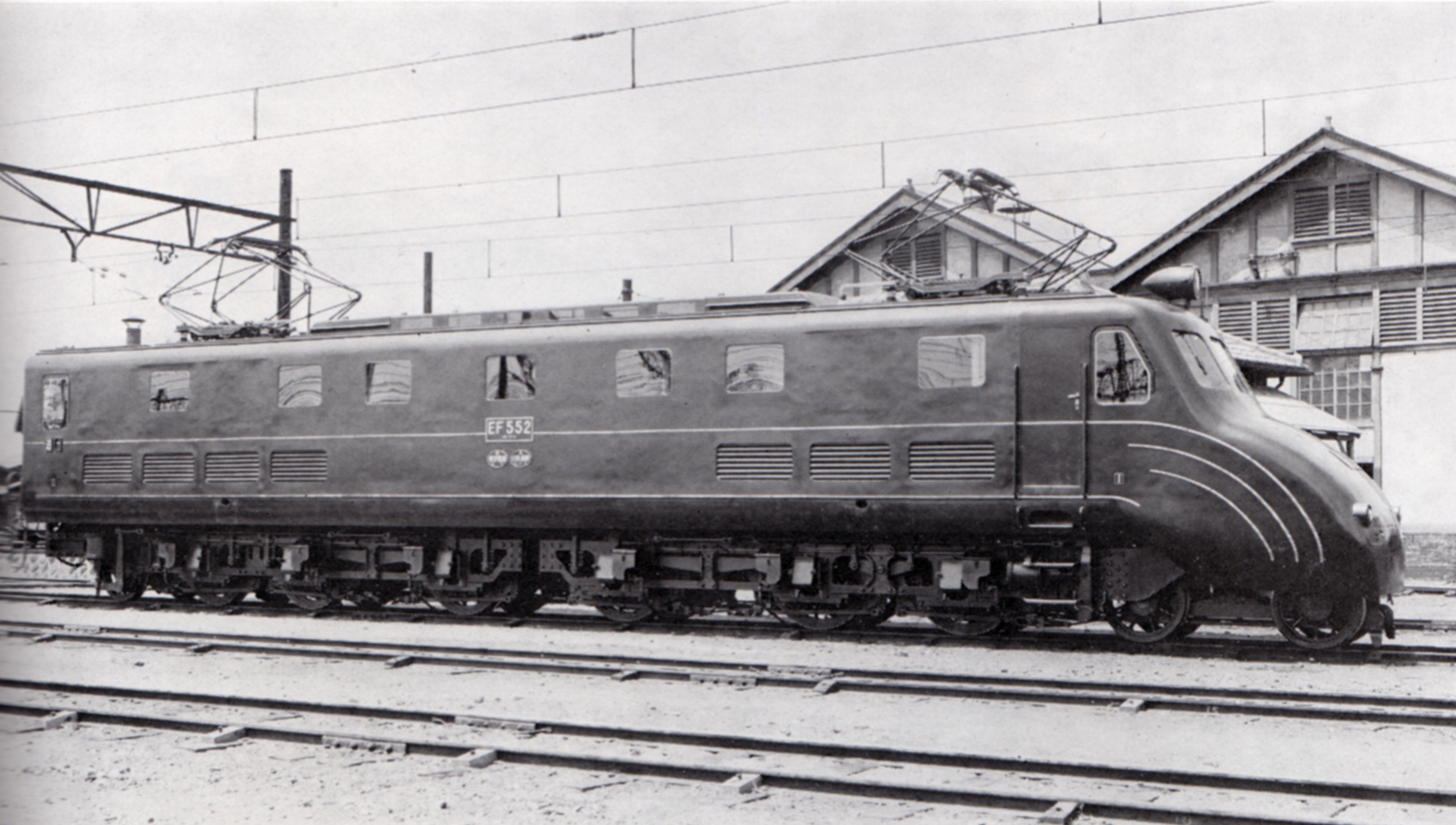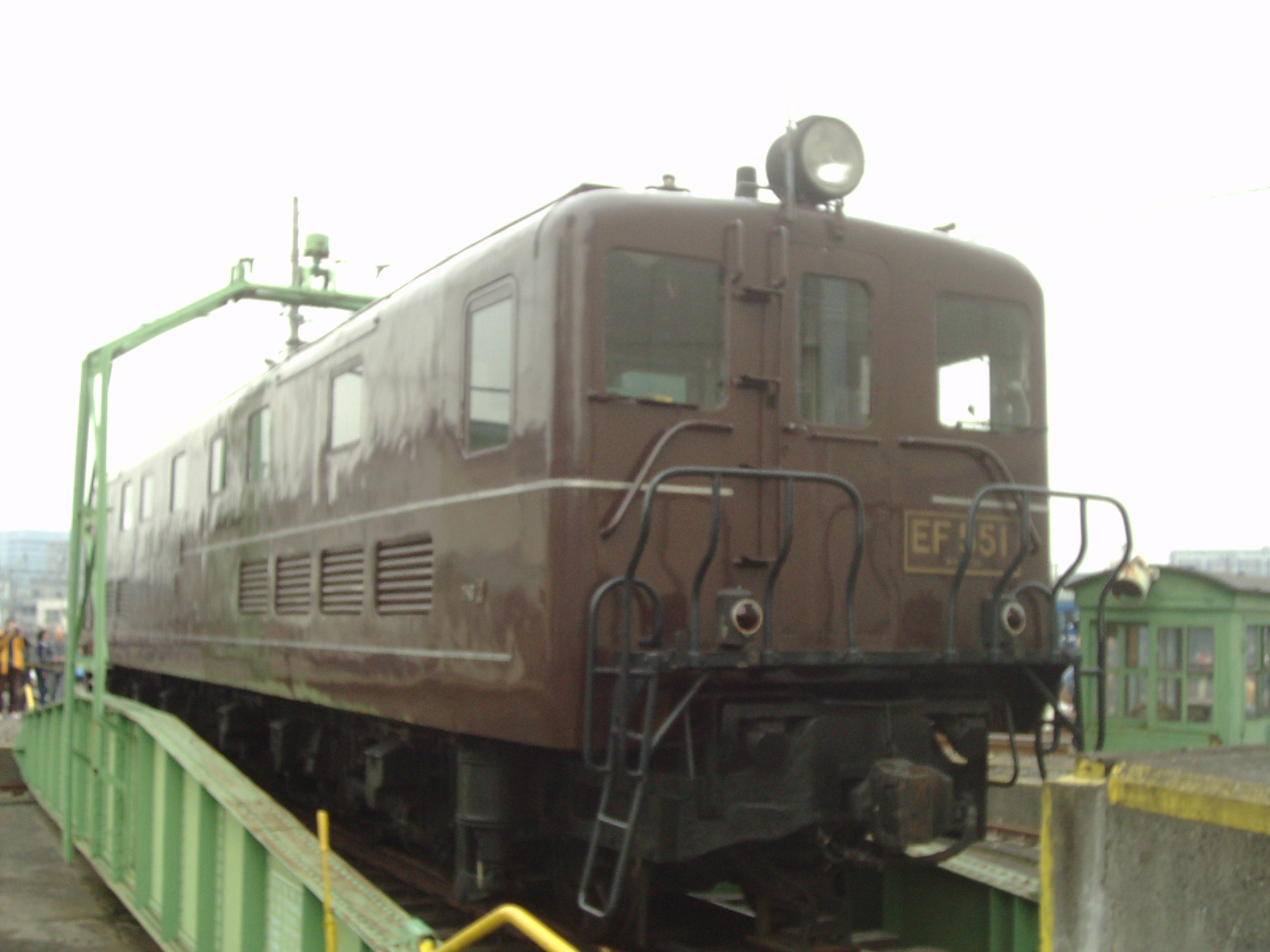JNR Class EF55 on:
[Wikipedia]
[Google]
[Amazon]
The is a 2Co+Co1 wheel arrangement
 Streamlined designs were adopted for railway rolling stock worldwide in the 1930s, and the
Streamlined designs were adopted for railway rolling stock worldwide in the 1930s, and the  As such, the Class EF55 were built with a streamlined design. Although based on the earlier EF53 design, the EF55s based on a unique non-symmetrical wheel arrangement with a streamlined cab at only one end. The number 2 end had a traditional-style cab with access deck. The use of rivets and bolts were kept to a minimum, and welding was used to create a smooth surface. A 1936 trial showed a 9% reduction in air resistance when the locomotives ran with the streamlined end at the front. However, using turntables to keep the streamlined end at the front proved inefficient for regular operations. As a result, the Class EF56 and EF57 locomotives reverted to boxier designs, though the post-war EF58 brought back a more streamlined look. With an operational speed of 95 km/h, the EF55 surpassed 120 km/h during a trial run.
As such, the Class EF55 were built with a streamlined design. Although based on the earlier EF53 design, the EF55s based on a unique non-symmetrical wheel arrangement with a streamlined cab at only one end. The number 2 end had a traditional-style cab with access deck. The use of rivets and bolts were kept to a minimum, and welding was used to create a smooth surface. A 1936 trial showed a 9% reduction in air resistance when the locomotives ran with the streamlined end at the front. However, using turntables to keep the streamlined end at the front proved inefficient for regular operations. As a result, the Class EF56 and EF57 locomotives reverted to boxier designs, though the post-war EF58 brought back a more streamlined look. With an operational speed of 95 km/h, the EF55 surpassed 120 km/h during a trial run.
 EF55 1 was designated as an important piece of railway heritage in 1978, and was subsequently restored to running condition, re-entering service in 1986 for use hauling special event trains. It was operated by
EF55 1 was designated as an important piece of railway heritage in 1978, and was subsequently restored to running condition, re-entering service in 1986 for use hauling special event trains. It was operated by
electric locomotive
An electric locomotive is a locomotive powered by electricity from overhead lines, a third rail or on-board energy storage such as a Battery (electricity), battery or a supercapacitor. Locomotives with on-board fuelled prime mover (locomotive), ...
type consisting of three locomotives built in 1936 by Hitachi
() is a Japanese Multinational corporation, multinational Conglomerate (company), conglomerate founded in 1910 and headquartered in Chiyoda, Tokyo. The company is active in various industries, including digital systems, power and renewable ener ...
, Kawasaki, and Tōyō Electric in Japan. They were nicknamed "hippos (''kaba'')" or "monster shoes (''kutsu no bakemono'')" in the 1930s, and later in the 1980s "Moomin
The Moomins (, ) are the central characters in a series of novels, short stories, picture books, and a comic strip by the Finnish writer and illustrator Tove Jansson, originally published in Swedish by Finnish publisher Schildts. They are a ...
".
Design
 Streamlined designs were adopted for railway rolling stock worldwide in the 1930s, and the
Streamlined designs were adopted for railway rolling stock worldwide in the 1930s, and the Japanese Government Railways
The Japanese Government Railways (JGR) was the national rail transport, railway system directly operated by the until 1949. It was a predecessor of Japanese National Railways and the later Japan Railways Group.
Name
The English name "Japanese ...
(JGR) tested such a design on a Class C53 locomotive in 1934. It was then decided that 20 Class C55 steam locomotives would be built with a streamlined design. In the same year, the Tanna Tunnel opened on the Tokaido Main Line, and all express trains switched from the mountainous and detouring original route. Because of the length of the tunnel (8 km), steam locomotives were eliminated from operating through it, and a new class of mainline electric express locomotives was needed to replace the Class C51 and C53, which hauled the '' Tsubame'' and '' Fuji'' services.
Operations
All EF55s were based atNumazu
is a city located in eastern Shizuoka Prefecture, Japan. , the city had an estimated population of 189,486 in 91,986 households, and a population density of 1,014 persons per km2. The total area of the city is .
Geography
Numazu is at the n ...
depot from 1936, and were operated on the Tokaido Line until 1952, when they were moved to Takasaki
is a Cities of Japan, city located in Gunma Prefecture, Japan. , the city had an estimated population of 372,369 in 167,345 households, and a population density of 810 persons per km2. The total area of the city is . Takasaki is famous as th ...
depot on the Takasaki Line
The Takasaki Line () is a Japanese railway line which connects Ōmiya Station in Saitama, Saitama Prefecture and Takasaki Station in Takasaki, Gunma Prefecture. It is owned and operated by the East Japan Railway Company (JR East).
All service ...
. The need to turn locomotives round due to the single cab proved to be the downfall of this small class, and the locomotives were placed in storage in 1958, and then officially withdrawn in 1964. Following withdrawal, EF55 1 was moved to the former Chūō Railway Institute near Nishi-Kokubunji Station for apprentice training purposes. EF55 3 was cannibalized to donate motors and other components to the ED30 prototype AC/DC electric locomotive, and EF55 2 was also cut up shortly after.
Preservation
 EF55 1 was designated as an important piece of railway heritage in 1978, and was subsequently restored to running condition, re-entering service in 1986 for use hauling special event trains. It was operated by
EF55 1 was designated as an important piece of railway heritage in 1978, and was subsequently restored to running condition, re-entering service in 1986 for use hauling special event trains. It was operated by JR East
The is a major passenger railway company in Japan and the largest of the seven Japan Railways Group companies. The company name is officially abbreviated as JR-EAST or JR East in English, and as in Japanese. The company's headquarters are in ...
, based at Takasaki depot, until it was finally withdrawn in January 2009. EF55 1 was moved from Takasaki to in January 2015, and exhibited at JR East's Railway Museum
A railway museum is a museum that explores the history of all aspects of rail related transportation, including: locomotives (steam, diesel, and electric), railway cars, trams, and railway signalling equipment. They may also operate historic ...
from 12 April.
See also
*Japan Railways locomotive numbering and classification
This page explains the numbering and classification schemes for locomotives employed by the Japanese Government Railways, the Japanese National Railways and the Japan Railways Group.
Steam locomotives
Pre-nationalization
Prior to the Railw ...
References
{{Jreastloco Electric locomotives of Japan 1067 mm gauge locomotives of Japan 2-C+C-1 locomotives 1500 V DC locomotives Preserved electric locomotives Railway locomotives introduced in 1936 Hitachi locomotives Kawasaki locomotives Streamlined electric locomotives